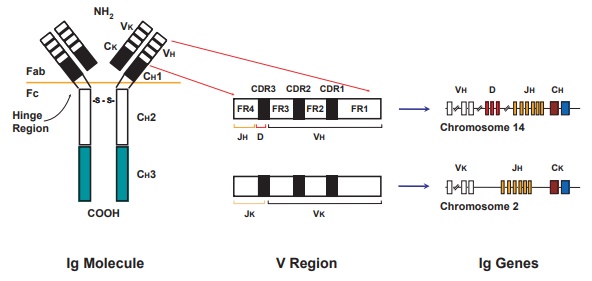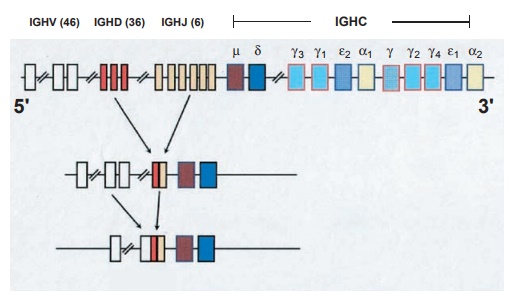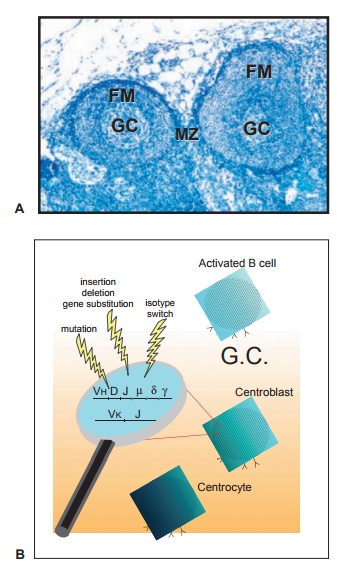Chapter: Essential Clinical Immunology: Chronic Lymphocytic Leukemia
B-Cell Activation and Maturation
B-CELL ACTIVATION AND MATURATION
The enormous diversity of the normal
B-cell-antibody repertoire initiates in the bone marrow where B lymphocytes
rear-range their immunoglobulin (Ig) variable (V) region gene segments coding
for the B cell’s receptor for antigen (BCR) (Figures 7.1 and 7.2). The
diversity in the repertoire continues to grow after binding antigen, when the B
cell enters a lymphoid follicle and, with the help of other cells and cyto-kines,
creates a structure called the germinal
center (GC) where the cell
proliferates and accumulates somatic
mutations in its BCR-encoding genes (Figure 7.3). These muta-tions may produce
amino acid changes in the binding site of the BCR, which can improve or create
new antigen-binding specificity. Enhanced affinity B cells survive, whereas
those having BCRs that either do not bind antigen or bind self-antigens die.
The GC reaction usually occurs in secondary lym-phoid follicles with the help
of T lympho-cytes. This mutation and selection process can take place in
response to bacteria with-out T-cell help in the marginal zones out-side of
lymphoid follicles, although in this case, antigenic stimulation does not
always induce mutation of IgVH
genes.

Figure 7.1 Ig
molecules and their genes. Ig molecules can be divided into two fragments, Fab
and Fc, by enzymatic digestion; the former fragment engages antigen and the
latter fragment mediates effector functions. The two fragments differ in IgV gene composition, with the Fab
region, containing the antigen-binding site, being composed predominantly of
the Ig variable region gene segments (IGHV,
IGHD, and IGHJ) and the Fc region
composed completely by an IGHC gene.

Figure 7.2 IGHV gene rearrangements. To code for a complete Ig molecule containing both
Fab and Fc regions, several Ig genes
need to be brought together from distinct locations and joined. This is a
multistep process involving first the rearrangement of one of thirty-six IGHD gene segments with one of six IGHJ
segments. Subsequently this unit is rearranged and combined with one of
forty-six IGHV genes. In normal
B-cell development, the first rearrangement contains the IGHC µ gene.

Figure 7.3 Germinal center and the germinal center reaction. A, Photomicrograph of two adjacent germinal centers within a mesenteric lymph node, with germinal center (GC), follicular mantle (FM), and marginal zone (MZ) areas. B, On close inspection of the DNA sequence of the rearranged IgVHDJH, one notices somatic changes that arise during the time the activated B cell resides in the GC. These changes involve predominantly point mutations and isotype class switching, although other less frequent events such as nucleotide deletion or insertion can occur. These changes occur at the centroblast stage of B-cell maturation; at the centrocyte stage, rescue from apoptosis is achieved by antigen binding through the BCR and T-cell interaction.
Related Topics